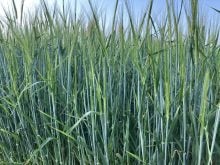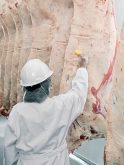The Canadian beef cow herd is showing signs of entering the consolidation phase of the cattle cycle. Beef cow inventories were smaller, but there were more beef breeding heifers on July 1. The U.S. cattle herd is estimated to have declined from last year. Feeder imports from Mexico and heavier carcass weights have supported U.S. beef production in 2024. Canadian fed carcass weights have been heavier than last year, supporting domestic production even with smaller slaughter volumes. Beef and veal export volumes are projected to surpass the 2022 high. Seasonality is re-entering the fed and non-fed markets. Feeder cattle prices in Alberta and Ontario have been softening since early August and are projected to be steady with last year by the end of September. Replacement ratios continue to increase.
Canadian cattle herd consolidating
The Canadian beef cow herd was in liquidation until May, when moisture conditions improved in the West. The reduction in cow slaughter volumes since then suggests the Canadian beef cow herd is entering the consolidation phase of the cattle cycle. The July 1, 2024 cattle inventory report, released by Statistics Canada, shows the Canadian beef cow herd declined 2.2 per cent from last year to 3.49 million head. Beef breeding heifers were up 0.8 per cent to 586,000 head. Canada’s dairy cow herd was mostly steady with last year at 969,400 head. Dairy replacement heifers were down 1.2 per cent to 405,400 head.

Pasture conditions across the Prairies varied this summer, with Manitoba and Saskatchewan in better shape than the Peace region and central Alberta. This has moved the fall calf run back to a more normal trend. After several years of large numbers coming off pasture early, western Canadian auction volumes through the first three weeks of September were just shy of 160,000 head, 29 per cent smaller than last year and 15 per cent smaller than the five-year average. These numbers are reminiscent of 2017 and 2019. Moisture conditions this year were considerably better than last year. La Niña began to move into Western Canada in August. Once fully in place, a weak to moderate La Niña is anticipated for the fall and winter of 2024-25, bringing a colder winter than last year, with sporadic moisture.
U.S. cattle herd estimated lower
USDA discontinued its July 1 cattle inventory report, at least for this year, citing budgetary constraints. This was disappointing news to the U.S. beef industry, as this report provides valuable information about the calf crop and next year’s marketings. Several leading market intelligence organizations have stepped in with their own estimates. There is a general agreement that the U.S. cattle herd as of July 1, 2024, declined. Estimates range from a one to 1.5 per cent reduction from last year. CattleFax estimated beef breeding heifers and cattle-on-feed to be higher than last year. All other classes of cattle are estimated to be steady to smaller than last year.

Year to date, U.S. feeder imports were almost 950,000 head, 22 per cent larger than last year and 17 per cent larger than the five-year average. Feeder imports from Mexico, at 850,000 head, were up 25 per cent from last year, and up 21 per cent from the five-year average. Imports from Canada, at 97,000 head, were up three per cent from last year, but down 11 per cent from the five-year average. Larger Mexican imports are anticipated to offset the decline in U.S. feeder supplies and support U.S. beef production in 2024.
Read Also

What to know before you go to Agribition 2025
If you’re attending Agribition 2025, this is the place to find out about tickets, dates and what’s happening this year.
Canadian steer carcass weights heavier
Canadian steer carcass weights have followed seasonal patterns so far in 2024 but remain heavier than last year. Weight gain has been economical, and feedlots have responded by keeping cattle on feed longer, producing heavier carcasses. The Cargill Guelph labour strike from the last week of May to the first week of July affected eastern Canadian marketing schedules, with cattle being shipped to Western Canada and the U.S. to manage supplies. Ontario steer carcass weights (federally and provincially inspected) averaged 1,014 lb. in June, 68 lb. heavier than last year and 82 lb. heavier than the five year average for June. But carcass weights quickly moved back to previous levels once operations resumed in July. In the West, steer carcass weights averaged 883 lb in June, 31 lb. heavier than last year and 25 lb. heavier than the five-year average.
Steer carcass weights have seasonally increased in the second half of the year and remain 18-22 lb. heavier than last year and 22-24 lb. heavier than the five-year average. Carcass weights are anticipated to trend heavier than last year into the fourth quarter.

Heifer placements as a percent of total feedlot placements have been below both last year and the five year average for the past three months. Between June 1 and August 1, heifers averaged 35 per cent of total placements, down from 43 per cent over the same period last year with the five-year average at 41 per cent. This also points to the possibility that some heifers were retained on cow-calf operations as replacement breeding stock.

Carcasses grading either AAA or Prime have been above both last year and the five-year average every month so far in 2024. Between January and August, 77.5 per cent of fed carcasses have graded either AAA or Prime, compared to 72.2 per cent last year with the five- year average under 70 per cent. Heavier carcass weights have driven the increase in quality grading this year.
In the U.S., carcasses grading Choice or Prime accounted for 83.6 per cent of all carcasses, up from 82.5 per cent last year.
Domestic fed, non-fed production
Domestic beef production (up to the week ending September 14) is down two per cent from last year and down three per cent from the five-year average. The decline in domestic beef production has been driven by non-fed production, which is down 12 per cent from last year and down six per cent from the five-year average. Fed production is steady with last year but down three per cent from the five-year average. Between May and August, domestic beef production has been below year-ago levels every month except July, when heavier-fed carcasses from Eastern Canada were working through the pipeline. There were some concerns that the Cargill Guelph labour strike would result in a backlog of cattle, but it appears feedlots were able to manage front-end supplies.

Canadian beef exports high
From January to July 2024, beef and veal export volumes were up three per cent from last year and up seven per cent from the five-year average. Canada is projected to export 512,000 tonnes in 2024. If realized, this will be the largest export volume since 2002. Exports were driven by the first quarter, up nine per cent from last year, while second-quarter volumes were down one per cent with the disruption at Guelph in June affecting trade flows. Beef export volumes in July were seven per cent lower than last year. Part of the reduction in beef export volumes in July can be attributed to the increase in live cattle exported into the U.S.
The U.S. continues to be Canada’s largest trading partner accounting for 74.1 per cent of market share. Japan (10.1 per cent), Mexico (6.4 per cent), South Korea (3.1 per cent) and Southeast Asia, including Taiwan (3.1 per cent), round out the top five markets for Canadian beef. These five markets account for over 96 per cent of Canadian beef export volume.

From January to July, export values were $2.74 billion, up one per cent from last year and up 21 per cent from the five-year average. Export values in the first quarter were 12 per cent higher than last year, with the second quarter up three per cent. Export values were down 12 per cent in value in July.
Live exports explode
From January to July, live slaughter cattle exports were 29 per cent higher than last year and 39 per cent higher than the five-year average. In the East, at 61,000 head, they were 72 per cent higher than last year and were three times higher than the five-year average. In the West, at 192,000 head, they were 19 per cent higher than both last year and the five-year average.
Seasonality drives fed prices
Alberta fed steer prices peaked at $262/cwt in June but softened around four per cent by August to $250/cwt. Ontario fed steers have strengthened through the year, topping at $251/cwt in August. U.S. fed steers peaked at C$265/cwt in July but have come under pressure in August to average C$254/cwt. Moving into September, both Alberta and Ontario fed steer prices have softened, with a seasonal shift in leverage from the feedlot to the packer. The cash basis will continue to influence where these cattle are slaughtered.

Lean trim drives Canadian cull prices
The Canadian cull cow market has benefited from a strong U.S. 85 per cent lean trim market this year. Alberta D2 cows found considerable tailwinds between January and August, dipping slightly in July. In August, Alberta D2 cows re-established new all-time highs at $193/cwt, up 30 per cent from last year and up 86 per cent from the five-year average. Ontario D2 cows closely mirrored their western Canadian counterparts, moving steadily higher between January and August, though some wind came out of the sails in May.
By August, Ontario D2 cows pushed above $178/cwt, also establishing new all-time highs, 28 per cent stronger than last year and 76 per cent stronger than the five-year average.

September has seen some softening of the non-fed mar- ket, also driven by the decline in 85 per cent lean trim prices. Despite recent softening, over the first three weeks of September, Alberta D2 cows averaged 33 per cent stronger than the same period last year with Ontario D2 cows 19 per cent stronger. There is expected to be some seasonal pressure on both Alberta D2 cows and Ontario D2 cows until November.
Feed grain prices below 10-year average
Lethbridge barley prices have been softening since January and moved below the 10-year average in both July and August, averaging $265/tonne in August. Ontario corn has been below the 10-year average every month so far this year, straddling the $210/tonne mark. Omaha corn has also been under pressure and has been below the 10-year average since February. Omaha corn averaged US$3.98/bushel in August and was under US$4/ bushel for the first time since October 2020. Lower feed grain prices have provided some relief to feedlot margins.

Feeder prices re-aligning with 2023
Most classes of Alberta feeder steers peaked in July, putting in new record highs, but counter-seasonally softened in August just before the beginning of the fall run. Historically, feeder prices don’t peak until September or October. Most classes of feeder steers faced some headwinds in September and have begun to re-align with last year.
In Ontario, all feeder steer classes strengthened between June and August, and by August re-established new record highs. By September, all Ontario feeder steer classes were softening and re-aligning with last year.

U.S. feeder steers under 700 lb. were largely rangebound between April and July, while feeder steers over 700 lb. caught slight tailwinds. The market turned in August, with all classes of U.S. feeder steers under pressure. By mid-September, prices for most weight classes were below a year ago.
Replacement ratios move higher
Replacement price ratios measure the price of a feed- lot replacement animal purchased against the price received from an animal sold on a per hundredweight basis. This ratio also plays an important role in profitability as more dollars required to pay for a replacement animal leaves fewer dollars available for other expenses and can reduce margins. Price ratios widened more in the East (six to 27 per cent) than in the West (one to six per cent) compared to the third quarter of 2023. The largest increase in price ratios in both regions was on 400- 499 lb. heifers and 500-599-lb. steers. Price ratios for 550-lb. and 850-lb. steers are the widest since 2015.
Risk management strategies are key to reducing feedlot debt exposure. The recent decline in the key interest rate should be positive news for the feedlot industry.

















